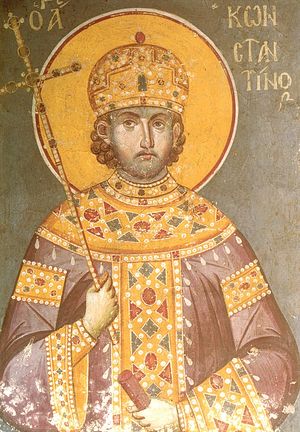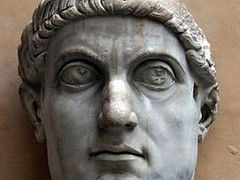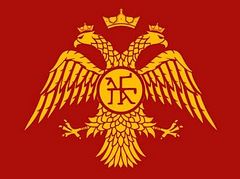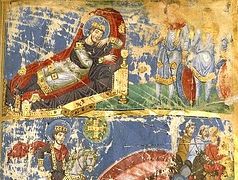One of the acts most significant in its consequences for world history was the Edict of Milan, published 1700 years ago[1] by the Roman Emperor Constantine. A quarter century after its publication, in 337, Emperor Constantine fell seriously ill and died. According to Eusebius, not long before his death he “considered that it was time to cleanse himself of his former sins, for he believed that everything in which he sinned as a mortal will be taken from his soul by the power of the mystical prayers and saving word of Baptism.”[2] In order to receive the sacrament of Baptism Constantine went to the palace in Nicomedia, which was located near the new capital of the New Rome—Constantinople, where the Emperor Diocletian had earlier built his residence. To Nicomedia came the bishops of the outlying cities. Eusebius relates the words spoken by the Emperor to the bishops assembled around his bed: “The much desired and long-awaited time has arrived, for which I have prayed as the time for salvation in God. It is time for us to receive the seal of immortality, and to partake of saving grace. I had thought to do this in the waters of the Jordan, where as an example to us, as it is told, the Savior Himself received Baptism; but God, Who knows what is profitable, has vouchsafed this to me here. Thus, we shall no longer waver, for if it please the Lord of life and death to prolong my existence, if it has once been determined that I be henceforth united to the God’s people as a member of the Church, that I should participate in prayers together with everyone, then through this will I submit myself to these rules of life, according to God’s will.”[3]
The bishops, presided over by the local ruling bishop Eusebius, closest of all bishops to the Emperor in his final years, performed the Baptism, after which, as another Eusebius (of Caesarea) writes, “Having been vouchsafed the Divine seal, he, exalted in spirit, was renewed and filled with divine light from his super-abundance of faith, rejoicing in soul and extremely amazed by the action of God’s power.”[4] The Emperor put on the white vesture of Baptism and wore no longer the royal porphyry.
On May 21, at around midday, on the last day of the feast of Pentecost, St. Constantine departed to stand before God. As his biographer writes, “At that very moment, the doryphoroi [imperial body guard] and all the guard tore their garments and threw themselves on the ground, beating their heads against it, filling the palace with lamentation, wailing and cries; they named Constantine their master, lord, and Basileus—and not so much master as father… The taxiarches [brigadiers] and lochages [commanders] called him their savior, guardian, and benefactor, while all the other battalions… grieved like abandoned sheep for their good shepherd, and the people wandered around the city expressing their emotional grief with shouts and cries. It seemed that many were overtaken by horror from their sorrow.”[5]
The Roman senate ranked the reposed emperor among the immortal gods, placing him alongside Ceasar, Augustus, Vespacian, Trajan, and certain other principates.
Constantine’s body was placed in a gold sarcophagus covered with porphyry and taken to Constantinople to be placed on a tall bier in a large hall of the palace. The Sarcophagus was left their for three and a half months, so that not only the emperor’s family and dignitaries could say farewell to him, but also his generals, officers and soldiers, imperial administrators and Roman citizens living in Constantinople, Rome, and other cities. From the palace the sarcophagus was taken to the Church of the Twelve Apostles and placed among the sepulchers of those who beheld the Logos. Constantine’s placement of burial also encouraged the Church to call him ikapostolos—equal to the Apostles, which was hindered neither by his baptism by an Arian Bishop, Eusebius of Nicomedia, nor his removal from Alexandria of the most zealous and eloquent defender of the Nicene Creed, St. Athanasius the Great. St. Constantine’s commemoration date was fixed on the day of his blessed repose—May 21 according to the Julian calendar.
Through Constantine’s labors not only did a new era unfold in the history of Rome—the edict of Milan decreed by him and the step-by-step creation of a symphonic relationship between the Church and state that followed marked the birth of a new Christian civilization across the Mediterranean, spreading later over all of Europe and beyond. The grandeur of this labor made Constantine truly equal to the Apostles, and the placement of his sarcophagus among the reliquaries of the twelve disciples of Christ served only as an opportunity to glorify him in that rank. Incidentally, the Western Church does not venerate him as among the saints, although in separate regions of the West—various parts of Sicily and Sardinia—in a word, in those countries that were longest under the authority of the Emperors of the New Rome, his cult is preserved.
The memory of St. Constantine in the Orthodox Church is bound up with the memory of his mother Helen. In the Church services dedicated to Sts. Constantine and Helen, the emperor’s vision of an image of the Cross in the skies that preceded his victory over the Roman usurper Maxentius and his conversion to faith in Christ is particularly emphasized. The troparion of the feast pronounces: “Constantine, who is thine Apostle among kings, O Lord, having beheld with his own eyes the sign of Thy cross in heaven, and like Paul having accepted thy call not from man, entrusted the reigning city to Thy hands, delivering it with safety for all time by the intercession of the Theotokos, O Thou who art alone the Lover of mankind.” Thus, in the Orthodox services dedicated to Sts. Constantine and Helen there is a prayerful request for the safety of Rome: “Delivering it with safety for all time by the intercession of the Theotokos, O Thou who art alone the Lover of mankind.” In another place in the services for May 21 there is the commemoration of another appearance of the Cross—its discovery in Jerusalem by the emperor’s mother: “The first Christian king, O Constantine, thou didst receive thy scepter from God: To thee wast revealed the saving sign, and by it thou didst conquer all the nations under the feet of the Romans, and having as thy invincible weapon the Life-Giving Cross, thou didst come to our God.”
In Russia the veneration of Sts. Constantine and Helen, assumed from the very beginning at its baptism, was a kind of prototype for the cult of Rus’s baptizer and equal-to-the-Apostles Prince Vladimir and his grandmother Olga—who received her own baptism in the New Rome, Constantinople, and was given the name of St. Helen. The service dedicated to the memory of St. Vladimir, served on July 15 according to the Julian calendar, contains many comparisons of his labors with the labors of St. Constantine: “Thou wast a second Constantine in word and deed: He was born into a Christian time and lived many years in Hellenism. Thou wast born of the Varangians, but didst love Christ Who loved thee, and didst ascend to Him in joy. Do thou ever pray to Him for those who honor thee.” The word “Hellenism is used here in the specific meaning that it had taken on in the eastern part of the Roman empire from the time of its Christianization and was then assimilated in Rus’. Having lost the meaning of the ethnonym, the word “Hellenic” began to signify a pagan, as opposed to a Christian and Romei, that is, Roman, although the language of the Romei and Christians was called Hellenic as before. In medieval Russia Hellenics was what they called the local alien peoples and pagans until they became Christians, be they unbaptized Slavs or Samoyeds of the north. In the service to St. Vladimir there is a parallel between Sts. Constantine and Helen on one hand, and Sts. Vladimir and Olga—in holy baptism, Elena (Helen)—on the other: “Thou didst proclaim the new love of Helen, having been the grandson of Olga. Thou wast a new Constantine the Great, crying out to Christ, O Vasily: blessed art Thou O God of our Fathers.” In the service dedicated to St. Vladimir the name given him in Baptism, Basil (in Russian Vasily), is mentioned in many places. This was the name of Emperor Basil, who goes down in history with the name Bulgar-slayer (Bulgaroktion), during whose reign the baptizer of Russia was baptized.
The general veneration of Emperor Constantine in Rus’ after its baptism can be seen in the fact that Russians were often given his name at baptism. Our ancient chronicles mainly preserved the names of princes and bishops, and among the Russian grand and local princes from the Rurich dynasty there are many known personages bearing the name of the holy Emperor Constantine. These were: Grand Prince of Rostov and Vladimir, Constantine Vsevolodovich, grandson of Yuri Dologoruky [the founder of Moscow.—Trans.] and uncle of holy Grand Prince Alexander Nevsky, who died in 1219; Prince of Ryzan, Constantine Vladimirovich, the great-great grandson of Sviatoslava, son of Yaroslav the Wise, who lived in the thirteenth century; Constantine Mikhailovich, the son of Holy prince and martyr Michael of Tver and holy Princess Anna of Kashin; Constantine Andreyevich, nephew of saint and prince Daniel of Moscow and grandson of Alexander Nevsky; Prince Constantine Romanovich of Ryazan, Constantine Rostislavovich of Smolensk, and Constantine Yaroslavovich of Galich. The name Constantine was also borne by the youngest (eighth) son of Holy Grand Prince Dimitry Donskoy, who ruled the lands of Uglich, and received the monastic tonsure at the end of his life with the name Cassian.
Among the Rurik dynasty princes who were named after Emperor Constantine are canonized saints: St. Constantine Vsevolodovich Yaroslavsky, the grandson of the above-named prince of Rostov and Vladimir, who bore the same name and patronymic, and holy Prince Constantine Feodorovich of Yaroslavl, nicknamed Ulemetz, who died in 1321.
In the pre-Mongol era, Russian people had as a rule two names—one for everyday use, derived from their Slavic, Scandinavian, or other origins, and the other the name of their patron saint. This is how it was for the baptizer of Russia, holy equal-to-the-apostles Prince Vladimir, in baptism Basil (Russian—Vasily). The first Orthodox saints in Rus’ where the sons of St. Vladimir Boris and Gleb, whose names are used as saint’s names, although their names in baptism where Roman and David. Thus, certain other Russian feudal princes of the distant past not mentioned here probably also received the name Constantine in baptism, but they went down in the chronicles with their everyday names, while their baptismal names have been lost to posterity.
Besides the princes, from early Russian history are known at least two private persons who nevertheless occupied important administrative positions—both in fact Novgorod mayors—named after St. Constantine. One of them was Constantine Dobrynich, son of Dobryn Nikitich, famous from the chronicles as well as folk legend. Constantine Dobrynich might have been remembered simply because he was not of the Rurikid line but was a close relative of St. Vladimir. His father was the brother of Malusha, or in Icelandic sagas, Malfrida, the handmaid of St. Olga and concubine of Prince Sviatoslav Igorevich, from which couple was born St. Vladimir. In other words, this Constantine was the cousin of the baptizer of Rus’ on his mother’s side. Constantine Dobrynich died in battle in 1022. In the following century another Constantine twice occupied the position of Novgorod mayor—Kosnyatin Mikulich, whose origins are unknown.
Even in an entirely different era the name Constantine captures the attention of the Russian royal house. Empress Catherine the Great had her grandson, born in 1779 to the family of the heir to the throne Pavel Petrovich and his wife Maria Feodorovna (born Princess Wurtemburg-Stuttgard), baptized in honor of St. Contantine, whose name was borne by twelve Roman Emperors, included the last one—Contantine Paleologue. This name was also given to the heir’s second son, with a far-reaching goal. In that age of Catherine the Great’s superlatively successful wars with the Ottoman Empire, the idea formed of dealing a death blow to the High Port (which was entirely realistic taking into consideration the aspect of international relations, interests, and the position of other great European powers, especially of Great Britain and Austria), and the restoration of an Orthodox Christian Empire allied to Russia, with its capital in Constantinople—the traditional goal of Russia’s foreign policy, at least from the time of Tsar Alexei Mikhailovich, if not from the age when the idea of Moscow as the Third Rome came into being. Catherine envisioned her newborn grandson as emperor of a restored Christian empire. In that case, a better name than Constantine could not have been found.
But history judged otherwise. Catherine’s project was never meant to come to fruition. The Ottoman Empire, which suffered significant cessations of its territory to Russia, including vast stretches in the northern Black Sea area, nonetheless survived to the 18th and 19th centuries and continued to exist up to the end of First World War, when three empires fell at once; but Constantinople (Istanbul) remains to this day a large city in modern Turkey. As for Grand Prince Constantine Pavlovich—although his older brother Emperor Alexander I died childless, he did not inherit the Russian throne after him, declining it in favor of his brother Nicholas due to his divorce with his wife Countess Anna Saxen-Koburg and subsequent morganatic marriage to Zhanna Gruzdinskaya, since according to his father Emperor Pavel’s famous act concerning royal succession, children born to a morganatic marriage cannot succeed to the imperial throne even though their parent may not have lost his right of succession. Constantine had the right to succession but his children would not, and perhaps even using the defect of his marriage as an excuse, he preferred to distance himself from imperial duties.
But the name of Grand Prince Constantine Pavlovich played a tragic role in events connected with succession to the throne on Senate Square in Petersburg, December 1825. On December 14, 1825, after the death of Alexander I, when the imperial family was deciding who would be the next emperor, there was resulting confusion in governmental spheres. The officers of several guard regiments lead their soldiers onto Senate Square with the intention of overthrowing the government in favor of Constantine who had refused the throne, and at the same time to change the regime. At their officers’ instigation, the soldiers who found themselves in the involuntary role of revolutionaries, shouted on Senate Square near the Winter Palace, “Long live Constantine and Constitution!” not at all suspecting that their shouts would cause such an uproar—an attempt upon the unlimited powers of the autocratic emperor. Because of the feminine ending of “Constitution” they assumed that this was the name of Constantine’s wife.
After Grand Prince Constantine Pavlovich, the name of the holy Emperor Constantine was born by other grand princes: the son of Emperor Nicholas I, Constantine Nicholaevich, known as a talented poet. He would sign his poems with the initials “C. R.”, meaning Constantine Romanov. Also, the poet’s son was given he same name. They were both killed after the abdication of Nicholas II and the regime change in Russia.
The veneration of Emperor Constantine in Russia was expressed by the fact that many churches and altars were dedicated to him throughout all of Russia’s Christian eras. Because St. Constantine is commemorated together with his mother Helen, all the churches that I personally know of are dedicated to both saints—Constantine and Helen. One of the churches in the Kremlin, destroyed in the 1930s, was dedicated to these two saints. It has not yet been rebuilt.
In our present times, the Russian Orthodox Church has approximately sixty churches dedicated to Sts. Constantine and Helen. Among them are some that were built in the post-Soviet period. One of them is now under construction. Three other Moscow churches in honor of Sts. Constantine and Helen were restored during the last twenty years. They all have the status of house churches: at the University of Land Management, at the Mezhev Institute, and at the Pyatnitsky Patronage. In the Moscow diocese outside the city there are five more Constantine and Helen churches: in Sergiev Posad in the Chernigov Skete of the Holy Trinity-St. Sergius Lavra, as well as parish churches in Istra, Klin, Verea, and in one village. There are five house churches in St. Petersburg dedicated to Sts. Constantine and Helen. One of them is at the Military Academy, another at a private high school, and two more at hospitals. Outside of Petersburg but within the St. Petersburg diocese there are three more churches: in Strelna, Vsevolozhsk, and in one village near Vyborg. There are thirty churches of Sts. Constantine and Helen in various Russian provinces, at least eight churches in the Ukraine, one in Belorus and one in the Kazakhstan capital of Astana. Far abroad are Russian Churches of Sts. Constantine and Helen in Australia (Syndey) (one), and two in Germany, one of which is located in Berlin.
Out of all the saints who lived during the epoch of Christianization of the Roman Empire from the fourth to sixth centuries, the name Constantine is one of the most well known and venerated in Russia, surpassed only by Saints Nicholas of Myra and Lycea, Basil the Great, Gregory the Theologian, and John Chrysostom. Ecclesiastical consciousness perceives St. Constantine as an image of the ideal ruler, regardless of the fact that Christians naturally allow that there is a difference between the historical Constantine and the ideal of him—we might say, the icon of him—intricately correlated though they be. And every truly effective ruler of Russia is inevitably compared in popular consciousness with this icon: in Russian history, with St. Vladimir and in world history, with St. Constantine—so that every high evaluation of the fruits of any such ruler’s efforts confers to him the appellation of a “new Constantine, or a “new Vladimir”.




